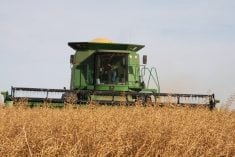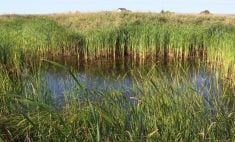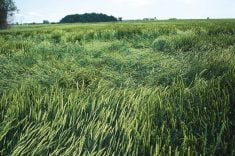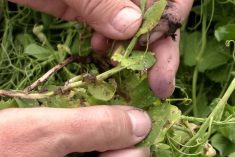Odd as it might seem, a study shows one of the processes used to extract protein concentrates from peas, for use in plant-based food products, may in some ways favour lower-protein peas.
First some background: a few weeks ago we got a note from the Canadian Grain Commission about its Harvest Sample program for 2023, in which the CGC called attention to its Grain Research Laboratory’s research projects, which rely in part on samples from the program. One of the featured projects, led by Dr. Ning Wang of the lab’s pulse crops team, used pea samples submitted via the program to study pea protein concentrates.
Read Also

Claas brings 1000 Series SP forage harvesters to Canada
In mid-August, Claas unveiled its new line of Jaguar forage harvesters at an event in Visalia, California, deep in the heart of that state’s dairy region.
The study looked at how different pea varieties and protein levels could contribute to chemical composition of those pea concentrates in plant-based products such as meat alternatives.
Yellow peas received from across the West via the Harvest Sample program between 2015 and 2020 showed annual mean crude protein content ranging from 221 to 233 grams per kg of dry matter; in the individual samples, crude protein content ranged from 163 to 305 g/kg.
“While the overall average crude protein content did not vary greatly from year to year, the large variation in crude protein among individual samples within a year suggested that environmental conditions, agronomic practices and genetic factors may impact this range,” Wang wrote.
The peas were dehulled and milled into flour, which then goes through a process called air classification. The flour passes through a spiral air stream, in which the fine protein concentrate is separated from the more-coarse starch concentrate.
It’s possible to recover those proteins instead using what’s called “wet extraction,” but some processors are more interested in the air classification process because it uses less energy, water and chemicals.
It’s already known that air classification is less efficient when the peas have relatively high crude fibre and fat content, so this study instead looked at how peas’ crude protein content affected the outcome.
The researchers found the protein separation efficiency (PSE) using air classification was “significantly higher” from milled pea flours with lower crude protein levels than from those with higher crude protein levels.
The researchers said that may be because the pea flours with lower crude protein showed larger-sized starch granules compared to flours with higher crude protein levels. In turn, larger starch granules are denser and less likely to be carried by the air stream into the fine fraction.
“Seed hardness” and “flour dispersibility” might also affect PSE, the researchers said.
By comparison, the higher-protein pea flours led to more small starch granules being concentrated into the protein fraction. And that opens up another proverbial can of worms — because even though the study shows more small starch particles in the fine protein as a result, air classification is considered to be better suited to using the higher-protein pea flour for other reasons.
The higher-protein flour makes for low oligosaccharides, overall higher protein concentration and foaming properties in the resulting protein fractions, compared to concentrates from low-protein peas.
How might all this help farmers? For a start: better processing outcomes. In the study, the protein concentrates made using air classification showed improved oil absorption capacity and oil emulsion capacity, which make them well suited to baked products or salad dressings.
Plus, Wang wrote, as we learn more about the variations between pea varieties and how growing environment affects protein and starch, this work may lead to more “appropriate sourcing” of peas — and make air classification a more efficient process to get at those sought-after proteins.
On top of that, of course, it shows submitting samples to the Harvest Sample program from across the widest possible range of regions and field conditions can be really helpful in leading researchers to findings such as these. GN















